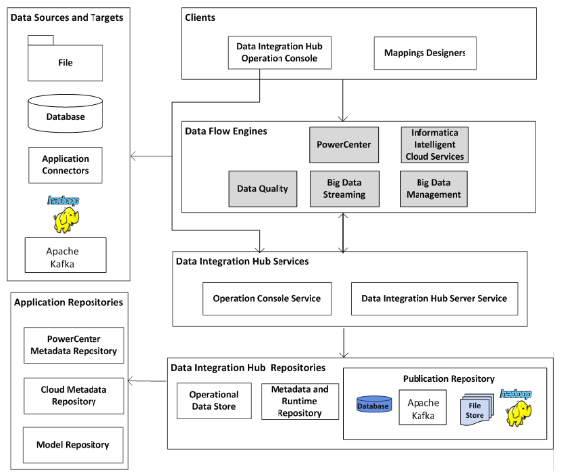Data Integration Hub Architecture
The Data Integration Hub environment consists of user interface clients, data flow engines, Data Integration Hub services and repositories, and external metadata repositories.
The following image shows the Data Integration Hub components:
Data Integration Hub contains the following components:
- Data Integration Hub Operation Console Web client
- User interface to manage applications, topics, publications, and subscriptions, and to monitor publications, subscriptions, and events. Administrators also use the Operation Console to manage users and system settings. Developers use the Operation Console to manage Data Integration Hub workflows and connections.
- Mappings designer clients
- User interfaces to define sources and targets, build custom mappings, and create workflows and tasks. Use the mappings designers if you use custom mappings.
- Data flow engines
- Engines that retrieve data from publication sources and send the data to subscription targets. You can use different flow engines for different use cases. For example, use PowerCenter to publish and subscribe to on-premises applications, and use Informatica Intelligent Cloud Services to publish and subscribe to cloud applications.
- Data Integration Hub Operation Console service
- Service that processes actions that users perform on the Operation Console and creates the structure for published data sets in the publication repository.
- Data Integration Hub Server service
- Service that starts and monitors Data Integration Hub workflows for publications and subscriptions.
- Data Integration Hub publication repository
- Database that stores published data until the subscribers consume the data. After the data retention period ends, Data Integration Hub deletes the data from the publication repository.
- Data Integration Hub metadata repository
- Database that stores metadata for Data Integration Hub applications, topics, publications, subscriptions, and events.
- Operational data store
- A repository that contains aggregated information for reporting purposes. When you install the Data Integration Hub Dashboard and Reports component of Data Integration Hub, Data Integration Hub creates the operational data store repository based on the database connection details that you supply.
- PowerCenter metadata repository
- Database that stores metadata for PowerCenter mappings, workflows, and transformations.
- Cloud metadata repository
- Database that stores metadata for cloud mappings and tasks.
- Model Repository Service
- Database that stores metadata for Data Engineering Integration and Data Quality mappings and transformations.
- Data sources and targets
- Sources and targets that you use to publish and consume data. You can use the following types of sources and targets:
- - Database. Tables and columns.
- - File. Binary, text, or unstructured files.
- - Application connectors. Connection objects for applications. Available when you use a custom mapping.
- - Hadoop. Hadoop Distributed File System (HDFS) and Hive data warehouses.

